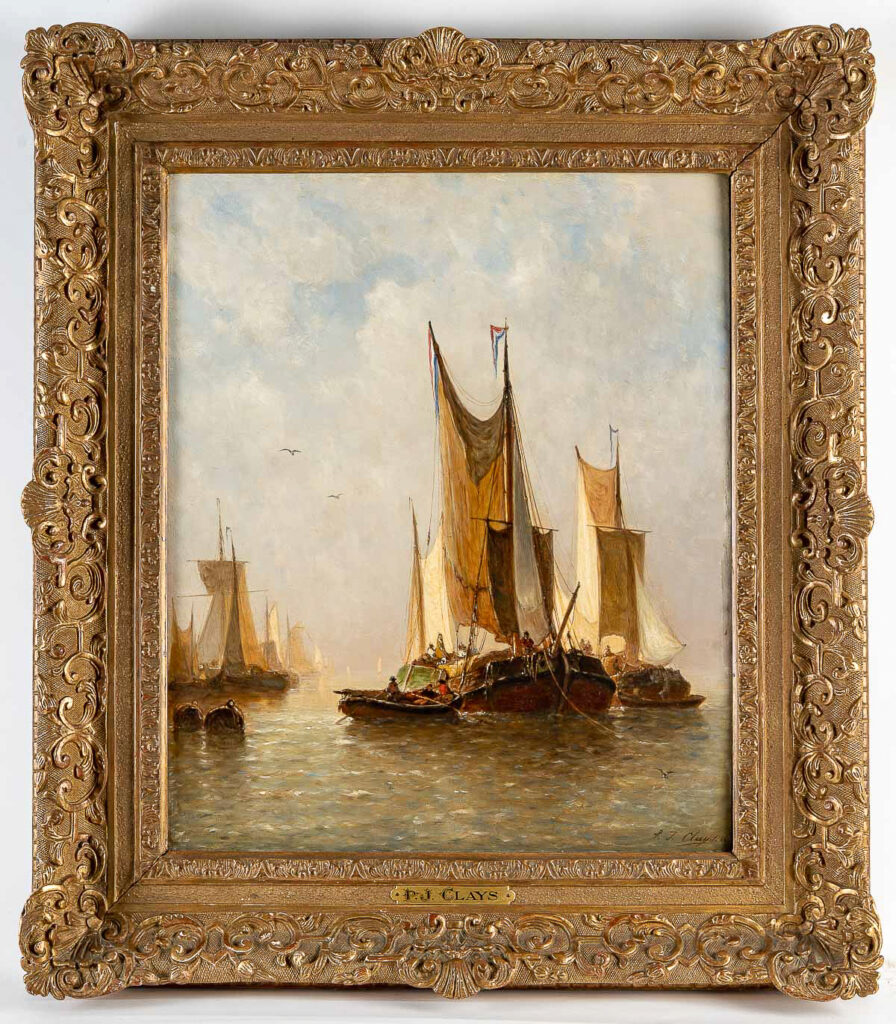Paul Jean Clays (1817-1900) – Les Thoniers huile sur panneau d’acajou vers 1864
Il sait donner à ses marines harmonie et grandeur. Une sorte de mélancolie pénétrante enveloppe toutes les œuvres que Paul Jean Clays a peintes. On sent que le peintre n’a pas seulement utilisé sa main ; qu’il met dans les œuvres qui viennent de sa pensée l’enthousiasme qui l’a saisi avant qu’il ne crée les œuvres. L’artiste est plus qu’un virtuose, c’est un contemplateur, un homme qui se sent ému par la présence de la Nature qui est si belle, si imposante, si difficile à traduire, que même les plus convaincus hésitent avant de s’y essayer.
Eugène Montrosier, Les Artistes Modernes: Peintres de Genre (Paris, Librairie Ch. Tallandier), pg. 39.
Paul Jean Clays is Flemish in his manner of painting; and in his choice of landscapes is somewhat like the Dutch. He does not paint the sea, but the Scheldt where it widens, and those gray and light waters which bear you in a steamer from Moerdyk to Rotterdam. With a proud feeling for these things, he expresses in the calme plat, in the gros temps, the humidity of the skies of Western Flanders, the sleep of the calmed water, or the caress, sometimes menacing, of the breeze which makes little, uneasy waves shiver around the Koffs loaded to the brim. The water has found in Clays a marvelously exact painter; he gives it movement, limpidity, life; and, with happy talent, he knows the spots where the sun’s rays cross it to fill it with light.
With his palette of colors and his technique, Paul Jean Clays, offers us a magnificent painting, we dive into the scene and assist in the real departure of the tuna boats in the middle of the 19th century. A sky that would like to let its beautiful blue hue pass, but that the clouds darken, the color and transparency of the sea are affected by this changing sky, suggesting that a sustained breeze has settled.
In this atmosphere, the sailors on the water or on the boat are getting ready for an imminent departure.
Very nice painting, between genre scene and landscape, in very good condition, signed in the lower right corner by Paul Jean Clays, served by a beautiful carved and gilded wooden frame.
Dimensions sans cadre Hauteur 49,5 cm – Longueur 40,5 cm.
Dimensions avec cadre Hauteur 68 cm – Longueur 58 cm.
The curators of many museums around the world collect the paintings of this excellent Belgian painter.
Biography:
Paul Jean Clays, painter of Belgian nationality, was born in Bruges on November 20, 1817, or 1819 and died in Schaerbeek on February 9, 1900.
As a young man, attracted by the sea, he joined small boats as a ship's boy. He wanted to learn about estuaries and the sea.
Son regard se forme rapidement, il saisit les couleurs que prend l’eau au fur et à mesure que les heures passent.
He studied in Paris with Charles Suisse and Theodore Gudin.
Paul Jean Clays was one of the first to refute the conventions of the Academy and a whole generation followed him. He was also one of the first to pave the way for realism and to shake, in the minds of his contemporaries, the absurd dogma of the hierarchy of genres.
« Ses tableaux se distinguent tous par la fraîcheur de l’aspect, le charme de la tonalité, la douceur transparente et le calme de leur expression. Le bleu, le brun-rouge et le blanc jaunâtre sont les trois gammes qui dominent. C’est avec ces forces uniques que l’artiste combine une harmonie chatoyante à effet d’autant plus attrayant que les qualités d’une facture magnifique, lisse, souple et brillante contribuent largement à en rehausser l’éclat. » Tel est le témoignage d’admiration d’Edmond-Louis de Taye, professeur d’histoire de l’Art à l’Académie des Beaux-Arts d’Anvers.
For the record, the municipality of Schaerbeek has named one of its streets Avenue Clays.
Bibliography:
Eugène de Sevn, Dictionnaire biographique des sciences, des lettres et des arts en Belgique, Ed. L’Avenir, Bruxelles, 1935.
Eugène Montrosier, Les Artistes Modernes : Peintres de Genre, Paris, Librairie Ch. Tallandier.
Lexique des peintres romantiques belges, Anvers : International Art Press, 1981.
Dictionary of Sea Painters, E.H.H. Archibald.
Museums:
Musees de Beaux Arts, Antwerp; Musee Royaux des Beaux Arts de Belgique, Brussels; Leicester Museums and Art Gallery; Graves Art Gallery, Sheffield; The Metropolitan Museum, New York; The National Gallery, London; Musée Royal de l’Armée Paris.




